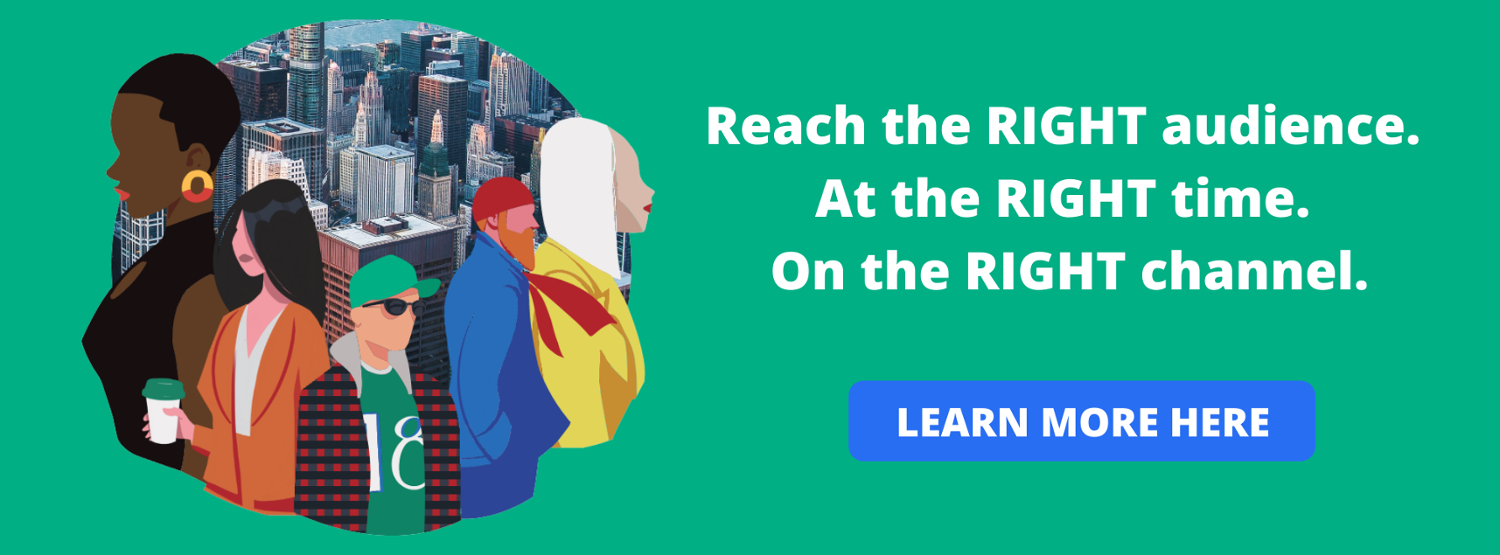Next up on our list of terms that can’t be interchanged: multichannel advertising and multichannel marketing. Because just like content advertising and content marketing describe two different processes, multichannel advertising and multichannel marketing have their important distinctions.
At the risk of throwing too many “ad” terms around and causing confusion, let’s get started…
Here’s what you need to know about multichannel advertising and multichannel marketing.
What is multichannel advertising?
Multichannel advertising is the process of creating and launching paid, promotional content among channels. These platforms might include direct mail, email, social media, or websites. Meanwhile the brick and mortar digital advertising might include email ads, sponsored social media posts, native ads, or display ads.
Multichannel advertising vs. multichannel marketing vs. omnichannel marketing
Multichannel marketing is similar to multichannel advertising. It also involves creating content for multiple channels. The difference is that that content is created to inform, educate, or entertain potential customers according to their needs and interests. That is, it’s not created to directly promote a product or service, rather about getting the message across to an audience. Marketing content is also distributed organically — without any paid promotion behind it — unlike advertising content.
As the American Marketing Association puts it: “Marketing is the process of identifying customer needs and determining how best to meet those needs. In contrast, advertising is the exercise of promoting a company and its products or services through paid channels.”
Take this user-generated content from Sharpie, for example. It’s posted on both Twitter and Instagram, highlighting a form of multichannel marketing used to build customer affinity and show audiences how they can have fun with the product.

So, that takes care of multichannel advertising vs. multichannel marketing. Now, let’s throw omnichannel marketing into the mix.
Omnichannel strategy is the process of creating a comprehensive, customized, and consistent experience for potential customers across multiple channels. So no matter where people interact with your brand — in-store, via email marketing efforts, on your website, or through social media — the touch points and messaging are connected, keeping them on the path to purchase.
A customer might start shopping on your website, for example, and then receive a personalized push notification reminding them to revisit their abandoned cart and complete the checkout process. After buying, they then receive a follow-up email with relevant product recommendations. In other words, omnichannel strategy provides the customer a seamless and integrated way to engage.
Look at this email from Ray-Ban. It syncs the e-commerce experience with email, reminding the shopper that they still have items in their cart. And if they check out now, they can enjoy free shipping returns.

To recap, multichannel advertising and marketing are all about engaging customers and increasing reach throughout platforms and in more than one channel. Multichannel advertising just takes it a step further by promoting specific products and services with paid ads. Meanwhile omnichannel marketing is about creating a connected cross-channel experience to aid in the buyer journey. Different channels require unique attention just like each customer experiences.
Benefits of multichannel advertising
Multichannel advertising is one of the most effective ways to reach customers on their favorite platforms with targeted, high-quality content.
Breaking that down further, these are the biggest benefits of multichannel advertising:
Reaching customers across various touch points
For a more robust marketing strategy and improved customer experience, give consumers more chances to engage with your brand by launching marketing campaigns for each channel they use.
According to Harvard Business Review, 73% of customers use multiple channels during their shopping journey.
McKinsey also found that 70% of shoppers are willing to try cross-channel shopping methods for convenience and accessibility.
Building a comprehensive customer view
Do you know what multichannel outreach yields? Multichannel data. That means gaining a clearer, more in-depth understanding of which channels your customers use, how they use them, and which types of content they’re most likely to engage with.
Delivering personalized experiences
With a wealth of customer data at your fingertips, you can better deliver personalized experiences — reaching customers through digital marketing where they’re already active and looking to engage with new content through.
According to a recent Infogroup study, 44% of shoppers would switch to a different brand if they provide a more personalized experience. And 53% say that the biggest thing brands get wrong is advertising irrelevant products to them. Going further, 40% of millennials say the most important thing a brand can do is deliver personalized messages that meet their specific interests.
Examples of multichannel advertising
There’s really no downside to reaching customers across various channels with messaging that speaks directly to their interests. As long as you have the right customer data to back up your choices — and high-quality content — you’ll be well on your way to increasing reach, engagement, and revenue.
Investment platform The Motley Fool, for instance, takes an aggressive, multichannel approach to its advertising. They already used search and social to attract new subscribers, but they still needed to add email to the mix. Half of their target audience (aged 55 and up) subscribes to email newsletters, and 57% click on relevant ads in emails. So, The Motley Fool started to place targeted ads in email newsletters from premium finance publishers. As a result, they generated hundreds of new subscribers each month.
Then there’s Rainmaker Ad Ventures, an online media buying powerhouse with cross-channel campaigns like email, web, and push notifications. As a result, Rainmaker Ad Ventures can advertise with publishers that don’t sell direct ads but still have massive, high-quality audiences. And they can drive traffic back to client sites and improve performance at scale.
Multichannel advertising technology
Advertising technology (AdTech) and marketing technology (MarTech) are converging to create a new beast: MadTech. As publishers are redesigning their marketing strategies for the digital age, they need the right tools to engage their audience, deliver personalized messaging, and tap into new revenue streams — automatically and all from one, unified system. Through optimized digital marketing, MadTech platforms give them the ability to gather, parse and analyze their data alongside the solutions to leverage that data effectively. While this may seem complicated, this gives customers a better experience across channels because publishers have melded their messaging.
Utilizing data in an advanced advertising technology is vital for multichannel distribution since it allows brands and publishers to deliver customized messaging at scale. That is, they can build one-to-one relationships with each customer in every channel — millions of times over, in just the right channels.
The way that multichannel advertising technology works is by collecting first-party data. First-party data is garnered directly from the audience through a particular source or single channel — usually the email address. With the help of analytics tools, CRM, personal accounts, surveys, subscriptions and other forms of feedback, first-party data can indicate customer behavior patterns. It is the most reliable form of consumer data, laying the framework for advertising and targeting campaigns.
By implementing the right MadTech solution, publishers and brands can leverage first-party data to target ads and increase revenues across a number of channels, like email, web and mobile push notifications, newsreaders, and more. As third-party data cookies are set to be phased out by the end of 2023, it is more important than ever to set up a first-party data solution and leverage that info to adopt a multichannel marketing strategy.
Learn more about the convergence of AdTech and MarTech, here.
Multichannel Advertising and Privacy
With recent crackdowns on digital privacy, publishers and brands are facing increasing challenges on top of the changes to third-party cookies. For example, Apple just announced new Apple Mail Privacy regulations. This announcement puts the brakes on pixel tracking and tracking email opens. This is simply the first domino, as more restrictions are bound to arrive.
Despite these changes, MadTech solutions should enable you to continue multichannel advertising across channels.
Reach the right customers — in a variety of channels
Jeeng was built to help brands and publishers advertise across channels, including email, web browsers, and push notifications. We match premium brand content with top-tier publishers to reach millions of consumers with targeted, relevant ads at the right time and on the channel each one prefers.
Ready to get started with multichannel advertising? Reach out today to learn more.




